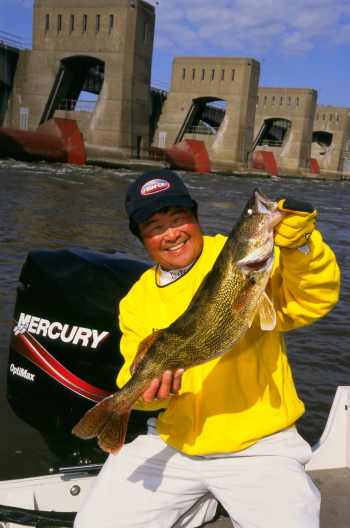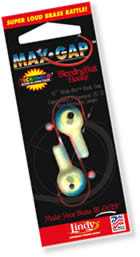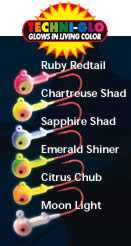|
Walleye fishermen looking for some early season fun can be
found on rivers throughout the Midwest. For Nick Johnson,
the target is the Mississippi River near his home in Elmwood,
Wis., about 30 minutes from Lake Pepin. He used the knowledge
he first learned on that stretch near Redwing, Minn., to become
the 2004 FLW Walleye Tour champion on the Mississippi River
farther downstream at Rock Island, Ill., last fall. “Even
in January and February, we are out there a lot,” said Johnson.
“There’s never a closed season.” Johnson said the Mississippi
River at Redwing also offered another advantage. Walleyes
react to current just like their river heritage has taught
them. They also react like walleyes in lakes and reservoirs
do when little or no current is present in Lake Pepin, a wide
spot in the Mississippi River. Johnson was forced to learn
tactics to deal with both situations. “As Pete Harsh once
said, ‘Don’t be a one-horse charlie,’ ” he said. As a result,
Johnson has an extensive repertoire. “Lead core is like my
teddy bear,” Johnson said. “But, it isn’t always the best
way to catch fish. It doesn’t always work. Trolling a long
stretch and only getting one fish off of one point during
the pass is not productive. I would have to take everything
up and set up for another pass. This is just not efficient.
Sometimes you can catch more fish by slowing down and fishing
one particular, isolated spot with live bait. If I can get
them casting a jig or crankbait in shallow water, I’m happy.
In the springtime, I spend a lot of time vertical jigging
as well.” Oh, that’s not to mention Johnson used three-way
rigs to win the FLW Walleye Tour championship.
|

Ted Takasaki with a
nice River Walleye
|
Spring sauger averages 15 inches and up on the Mississippi.
But, walleyes topping seven pounds often wind up in the
net. One thing that determines early season success is
totally beyond the power of fishermen to control. That
factor is the health of the shad population, Johnson said.
A shad population down in number enhances the bite. For
example, heavy rains and high water last year delayed
good shad spawns. The forage fish weren’t able to grow
to the four or five inch size required to make it through
the winter. Their numbers aren’t there now, and Johnson
anticipates a good bite. By February, fish are staging
in holes near spawning areas. Sauger are deep, perhaps
25 to 35 feet. Walleyes tend to be shallower in as little
as 3 to 4 feet of water even during the height of winter,
he said. Most walleyes and sauger spawn from the head
of Lake Pepin to the dam seven miles upstream. The trick
is to keep moving until you find them. Look for marks
on your electronics that are connected to the bottom.
Walleyes in rivers rarely suspend. “If I’m not seeing
fish on the sonar screen, I’m not spending too much time
there,” Johnson said. |
Before the spring rains raise the river and make the water
dingy, Johnson and his pals have been known to put underwater
cameras down to see 20 or 30 fish on a spot, all about to
spawn. But, they won’t eat with reproduction on their mind.
They could fish that spot all day and not get one. When high
water comes, they move into flooded grass far back in the
backwaters where they are hard to reach. They’ll also take
refuge in washboard bottom areas where water action has created
ripples on the sandy bottom where they can hide from current.
“I never pass one of those areas up,” he said. Everyone knows
about the fish at the dams, where pressure is intense.

Lindy's
Fuzzy Grubs |
Keep it simple. For the deeper sauger, vertical
jig with a big enough Fuzz-E-Grub to stay straight below
the boat in whatever current and wind conditions you face.
Add a fathead or shiner. Use a stinger hook if there’s
not too much debris. Use your trolling motor to slip with
the current or hover and work the holes from side to side
and up and back. |
 |
 |
For The shallower walleyes, look for steeper
breaks with a sand bar that cuts the current. Cast a Max
Gap jig with a Munchies Thumpin’ Ringworm. Keep things
light - an eighth or three-sixteenth oz. jig is best for
a slow fall. Step up to a quarter ounce if the current
is fast. Larger swirl tail grubs, like the Munchies Thumpin’
Grub also work. Stick with a handful of colors, such as
chartreuse, white and black in clearer water and bright
colors when things turn muddy. Johnson thinks the best
time on the Mississippi River comes at the end of April.
Water has reached 52 to 56 degrees. Most of the spawning
is done, and he starts finding walleyes in Lake Pepin.
He disputes that spawned-out fish need rest |
“All the fish don’t spawn in one night. They bite and they
bite hard. They are just scattered.” Walleyes set up on larger
concentrations of shad wherever that might be. In higher water,
current plays a role both in the river and to a lesser extent,
in the lake. Look for current breaks that form eddies. Look
for flooded willows, stumps, weeds, even shallow bays....
anything with an edge for walleyes to push baitfish against
and attack. “They use the edges like a wall,” Johnson said.
Another key to locating them is to be aware they tend to concentrate
in the warmest water in places featuring rocky rip rap. Now
is the chance to pull three-ways in eddies formed by gravel
bars or clam beds. He uses two different styles of weights.
One is the common bell sinker in one to two ounce sizes. However,
a pyramid sinker imparts an action Johnson likes. It will
hang up from time to time on bottom features like a rock or
a clam shell. As it does, his medium-action 8 1/2 to nine
foot downrigger rod in the rod holder loads up. As the boat
moves forward, the pyramid-style sinker frees itself and shoots
forward. If a walleye or sauger is lurking nearby, the action
is often enough to trigger a vicious strike. “It’s a cat and
mouse thing,” Johnson said. He uses a medium-action rod to
hold in his hand, too. It is shorter than the downrigger rods,
say seven feet, but he needs the softer action and added length
to act as a shock absorber. If not, a frisky walleye could
straight out the light-weight hooks that many floating jigs
feature. Forget that stuff about having your line at a 45-degree
angle to the water, he added. “I’ve been known to have it
50 feet back, but make sure you’re on the bottom,” he said.
He uses minnows, hooked through the lips or near the tail,
to May 1, then switches to leeches hooked through the sucker
or a nightcrawler hooked in the middle to add action and a
bigger profile. His main line is 10 pound test. The leader
is usually six feet long and made of 8 pound line. Try a variety
of colors on your floaters. He also likes the Lindy Rattlin’
Hooker. How fast? “I’ve been known to go downstream at 3 mph
to trigger fish by July,” Johnson said. Let the fish tell
you want they want. Johnson never leaves home without his
leadcore after March 1. Again, keep it simple. Tie on a barrel
swivel, an eight to six pound braided leader and a snap.
 |
He normally uses a number 5 or number 7
Shad Rap. Sometimes, you’ll catch him using floating stick
baits early in the year. “A lot of guys make it too hard,”
he said. One tip - Johnson does custom paint jobs, painting
some lures solid chartreuse, solid black, solid brown
and solid orange with purple backs. Best speed is 1.8
to 2 mph, but he’s been known to troll as fast as 4 mph
to trigger fish. Cabin fever got you down? Tired of looking
through a little hole in the ice? |
Get to the nearest river where it’s always open season on
walleyes. Dan will be speaking at the Walleye
Masters Institute in Rolling Meadows, Illinois on March 5th.
Make sure you reserve your spot and learn more about fishing
rivers and catching springtime walleye and saugers by calling
630-842-8199.
|

